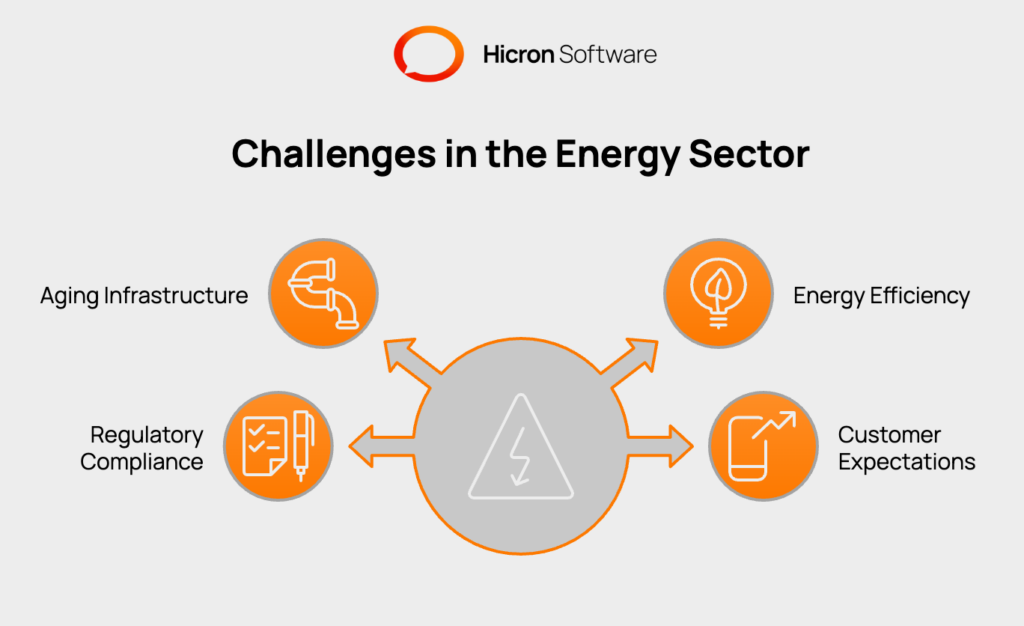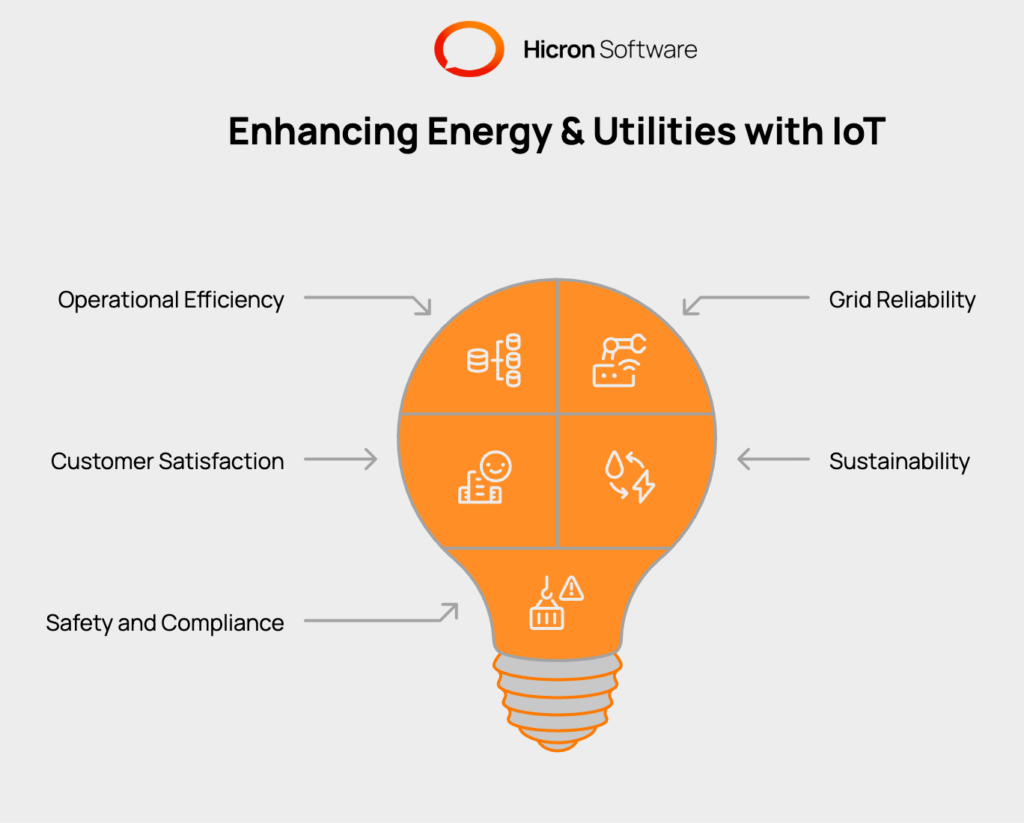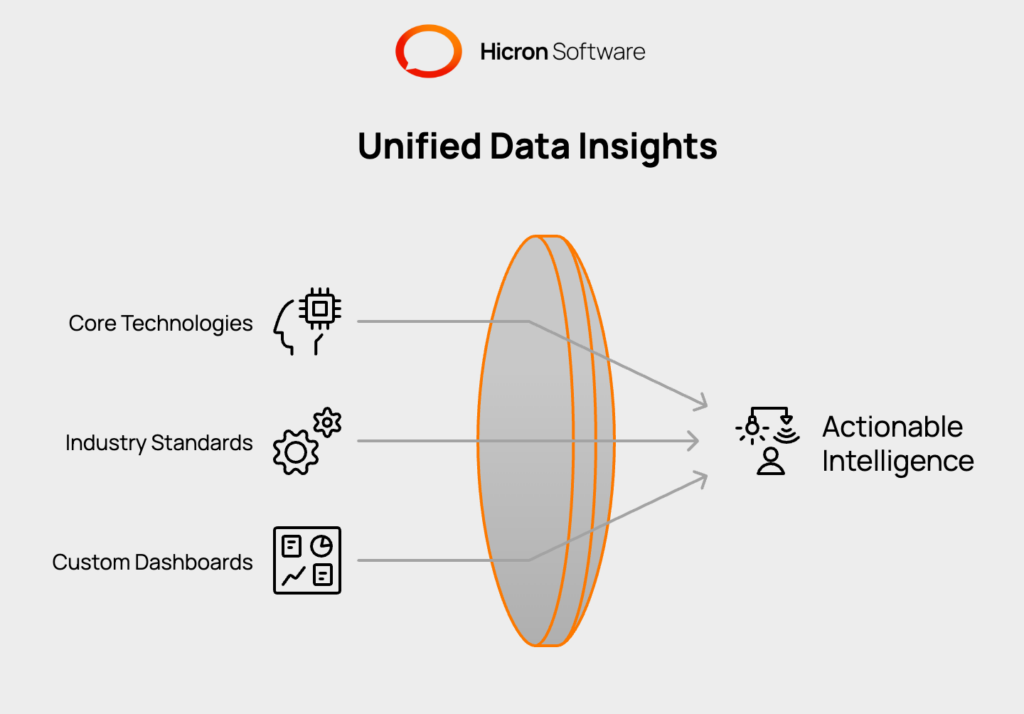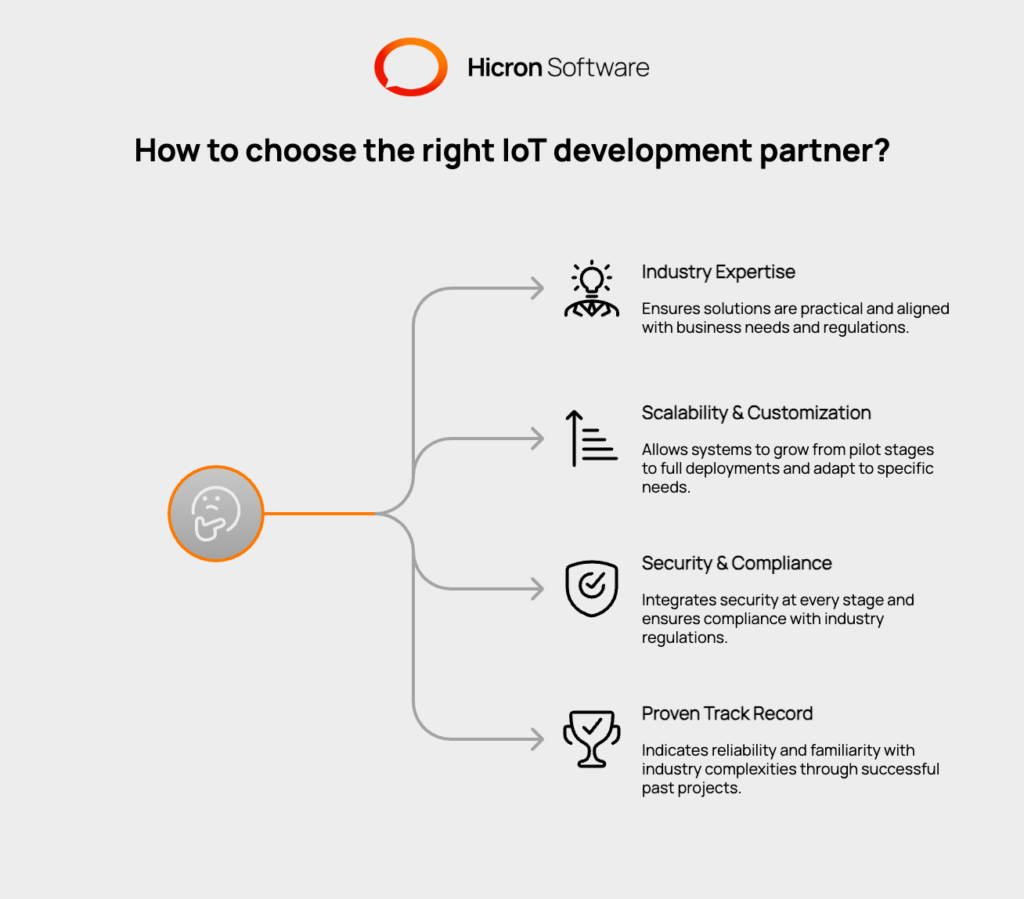10 Real Estate Software Development Companies in 2025
- February 03
- 9 min

Energy and utilities IoT development in modern infrastructure refers to the integration of Internet of Things (IoT) technologies within the energy and utilities sector to improve resource management, operations and support sustainable practices. This involves deploying connected devices, sensors, and advanced analytics to monitor, control, and optimize energy production, distribution, and consumption.
By leveraging IoT, modern infrastructure can achieve real-time data visualization, predictive maintenance, and system integration, enabling smarter grids, decentralized energy systems, and improved customer experiences. This development is pivotal in creating a resilient, efficient, and sustainable energy ecosystem.
This article explores how IoT development is transforming the energy and utilities sector. Key topics include practical applications like smart grids and predictive maintenance, as well as the technologies driving these advancements.
Key Takeaways:
The Internet of Things (IoT) is bringing major change to the energy and utilities sector by connecting devices and systems for real-time data collection and sharing. For industry professionals, IoT offers improved asset management, reliable service, and increased operational efficiency. Dedicated energy & utilities IoT development leads to practical improvements, such as
By adopting IoT solutions, organizations can resolve ongoing challenges, increase efficiency, advance sustainability efforts, and improve customer engagement. This article outlines the practical benefits of IoT development for energy and utilities, with a focus on key use cases like smart grids and predictive maintenance, as well as the main technologies that drive these developments.
Energy and utilities IoT development is the specialized process of designing and deploying interconnected systems to monitor, manage, and optimize the generation, transmission, and consumption of energy.
At its core, this involves creating a network of physical assets embedded with sensors and other hardware that gather operational data. This information is then transmitted via secure connectivity protocols, like cellular or LoRaWAN networks, to a central software platform. There, applications and analytics tools process the data to provide actionable intelligence.
|
Component |
Examples |
Description |
|
Hardware (sensors, devices) |
Smart meters, pipeline pressure sensors, IoT-enabled solar panels, GPS trackers on service vehicles |
These are the physical objects embedded with sensors and actuators that collect data from the environment or equipment. They form the foundation of the IoT system by gathering raw information directly from the assets. |
|
Software (platforms, applications) |
Energy management platforms, predictive maintenance applications, customer engagement mobile apps, data analytics dashboards |
This layer processes the data collected by the hardware. It includes platforms for managing devices, applications for analyzing information, and interfaces for users to view insights and control operations. |
|
Connectivity (networks, cloud integration) |
Cellular (4G/5G), LPWAN (LoRaWAN, NB-IoT), Wi-Fi, satellite networks, cloud platforms (AWS, Azure, Google Cloud) |
This is the communication infrastructure that transmits data from the hardware to the software. It ensures that information is securely and reliably sent for processing, storage, and analysis, often utilizing cloud services for scalability. |
The entire solution must be built to address the distinct demands of the sector, from modernizing old infrastructure and improving energy efficiency to meeting strict regulatory requirements. A generic approach is insufficient for a couple of reasons:
IoT solutions require careful customization to handle the scale and complexity of utility operations.
The energy and utilities sector faces several pressing issues that require modern solutions.

A primary concern is aging infrastructure, where legacy equipment often leads to operational inefficiencies and unexpected failures. Without predictive capabilities, maintenance becomes reactive and costly.
Concurrently, there is a growing demand for improved energy efficiency and sustainability, driven by both consumer awareness and environmental goals. Companies must find ways to optimize resource consumption across their networks.
The industry is subject to stringent regulatory compliance and safety standards, which necessitates constant monitoring and accurate reporting.
Customer expectations have shifted; consumers now demand greater transparency, access to real-time data about their usage, and more control over their energy consumption. Addressing these multifaceted challenges is essential for the continued viability and evolution of energy and utility providers.
The practical applications of IoT in the energy and utilities sector address core operational challenges. These technology-driven solutions are changing how energy is managed from production through to consumption.
|
Application |
Description |
Key Benefits |
|
Smart Grids |
Utilizes sensors and communication tech for real-time monitoring and control of the electrical grid. |
Improves grid stability, reduces outages, and optimizes energy distribution. |
|
Predictive Maintenance |
Employs sensors to monitor equipment health and predict failures before they occur. |
Minimizes downtime, lowers repair costs, and extends the life of assets. |
|
Energy Efficiency |
Tracks and analyzes energy consumption data across the network and for end-users. |
Reduces operational waste, lowers costs, and helps meet sustainability goals. |
|
Renewable Integration |
Manages the variable output from sources like solar and wind to ensure grid balance. |
Increases renewable energy use while maintaining a reliable power supply. |
|
Smart Metering |
Automates the collection of energy consumption data from customers for real-time billing. |
Provides accurate billing, improves customer engagement, and reduces manual labor. |
|
Asset Management |
Enables remote tracking and control of critical infrastructure, including remote or inaccessible assets. |
Enhances operational oversight, improves security, and reduces on-site visits. |
Smart Grids
By placing sensors and communication technologies throughout the power grid, utilities can observe electricity flow in real time. This enables dynamic adjustments to energy distribution, prevents outages by rerouting power, and helps balance loads during peak usage. These actions support a stable and reliable electrical network.
Predictive Maintenance
IoT sensors attached to critical equipment such as transformers, turbines, and pipelines continuously capture operational data like temperature, vibration, and pressure. Systems analyze this information to identify potential equipment failures before they occur, so maintenance teams can perform proactive repairs, minimize downtime, and extend the life of assets.
Energy Efficiency
IoT solutions offer detailed insights into energy consumption for both providers and customers. Utilities can find and correct inefficiencies within distribution networks. Consumers can use smart devices and applications to monitor their usage patterns and make informed decisions that reduce energy costs.
Renewable Energy Integration
Bringing renewable sources like solar and wind into energy grids adds complexity. IoT systems support management by supplying reliable forecasts of energy production and automating the necessary adjustments to keep the grid stable as supply changes.
Smart Metering
Automated Metering Infrastructure (AMI), or smart meters, replaces manual readings with direct transmission of consumption data to the utility. This enables accurate, real-time billing and lets customers clearly see their energy use, helping them manage their consumption effectively.
Asset Management
IoT supports the remote monitoring and management of widespread infrastructure. For example, operators can observe performance of substations and pipelines, detect issues such as leaks or tampering, and control operations through a central platform. This approach enhances security and operational control.
IoT makes the energy and utilities sector well-organized by improving resource management and lowering costs through real-time monitoring.

Developing and deploying an effective IoT solution in the energy and utilities sector follows a structured, multi-stage process. This approach ensures that the final system aligns with specific operational goals and delivers measurable value. Each phase builds upon the last, from initial concept to ongoing performance improvement.
|
Phase |
Description |
Key Activities |
|
Needs Assessment |
Identifies the specific operational challenges and business goals that the IoT solution will address. |
Defining project scope, pinpointing inefficiencies, setting key performance indicators (KPIs), stakeholder interviews. |
|
Solution Design |
Creates a detailed blueprint for the customized IoT solution, including hardware, software, and connectivity. |
Selecting sensors and devices, architecting the data platform, planning network infrastructure, designing user interfaces. |
|
Implementation |
Involves the physical deployment and setup of all components of the IoT system in the operational environment. |
Installing hardware on assets, configuring software platforms, establishing communication links, initial system testing. |
|
Integration |
Ensures the new IoT system connects and communicates effectively with existing business software and legacy systems. |
Connecting to enterprise systems (e.g., CRM, ERP), creating data pipelines, ensuring data consistency across platforms. |
|
Monitoring & Optimization |
Focuses on the continuous analysis of performance data to refine and improve the IoT solution over time. |
Tracking KPIs, analyzing data for insights, performing system updates, fine-tuning operational rules and alerts. |
Needs Assessment
The first step involves a thorough needs assessment to identify the precise challenges and objectives the IoT solution will address. This could involve pinpointing sources of inefficiency in the grid, defining goals for reducing maintenance costs, or outlining new customer service standards. This foundational stage clarifies the project’s scope and desired outcomes.
Solution Design
Following the assessment, the solution design phase begins. Here, architects and engineers develop a blueprint for a customized IoT solution. This includes selecting the appropriate sensors and hardware, defining the software platform architecture, and planning the connectivity strategy. The design is tailored to the unique environment of the energy or utility company.
Implementation
With a solid design in place, the implementation stage involves the physical deployment of the IoT system. This includes installing sensors on equipment, setting up communication networks, and configuring the software platforms. This hands-on phase brings the designed solution into the operational environment.
Integration
A critical part of the process is integration. The new IoT solution must work correctly with the company’s existing enterprise systems, such as asset management software, billing systems, and customer relationship management (CRM) platforms. This ensures that data flows smoothly across the organization and that the new technology complements legacy infrastructure.
Monitoring and Optimization
After deployment, the process shifts to continuous monitoring and optimization. Using data analytics, operators track the performance of the IoT system against key metrics. The insights gathered are used to make ongoing adjustments, refine operations, and continually improve the system’s effectiveness and return on investment.
A successful IoT implementation in the energy and utilities sector depends on a robust technological foundation, adherence to industry standards, and effective data visualization. These components work together to turn raw data into actionable intelligence, driving operational improvements and informed decision making.

Several key technologies form the backbone of modern IoT systems in this industry.
To ensure security and interoperability, IoT solutions must conform to established standards and regulations.
|
Category |
Description |
Examples |
|
Communication Protocols |
Ensures that devices and platforms from different manufacturers can communicate effectively and securely. |
MQTT, OPC UA |
|
Security and Management |
Provides broad frameworks and guidelines for IoT security, data management, and system interoperability. |
ISO/IEC family of standards |
|
Regulatory Compliance |
Mandates adherence to industry-specific rules for infrastructure protection and data privacy. |
NERC CIP, GDPR |
Raw data is only useful if it can be understood. Custom dashboards provide an intuitive, visual interface for monitoring operations and making strategic decisions in energy and utilities sector.
|
Aspect |
Description |
Key Features/Examples |
|
Essential Features |
Provides an intuitive, visual interface for monitoring operations and making strategic decisions based on real-time data. |
|
|
System Integration |
Connects the dashboard with other critical business and operational systems to create a single, unified view of the entire operation. |
|
The integration of IoT in the energy and utilities sector is transforming how resources are monitored, distributed, and consumed. Emerging trends in this space promise to enhance efficiency, sustainability, and innovation across the industry.
Selecting the right IoT development partner plays a vital role in the success of projects within the energy and utilities sector. A suitable partner provides both technical skills and strategic insight into industry demands. When making your decision, consider the following factors:
Industry Expertise and Experience
Scalability and Customization
Security and Compliance
Proven Track Record
By weighing these key criteria, you can confidently select an IoT partner equipped to help your organization reach both its operational and strategic objectives.

The adoption of Internet of Things technology represents a fundamental shift for the energy and utilities sector. By integrating intelligent devices and data analytics, companies can achieve new levels of operational efficiency, improve customer satisfaction through reliable service, and advance sustainability goals. The strategic implementation of IoT is no longer a future concept but a present-day necessity for building a more resilient and responsive energy infrastructure.
It refers to the integration of IoT technologies to monitor, manage, and optimize energy production, distribution, and consumption in the energy and utilities sector.
IoT improves operational efficiency, enhances grid reliability, supports sustainability efforts, and provides real-time data for better customer engagement.
IoT systems manage variable outputs from renewable sources like solar and wind, ensuring grid stability and optimizing energy distribution.
IoT tackles issues like aging infrastructure, energy inefficiency, regulatory compliance, and the need for real-time customer data and insights.
Key trends include AI-driven analytics for autonomous grid management, edge computing for faster decision-making, and IoT applications in microgrids for decentralized energy systems.
